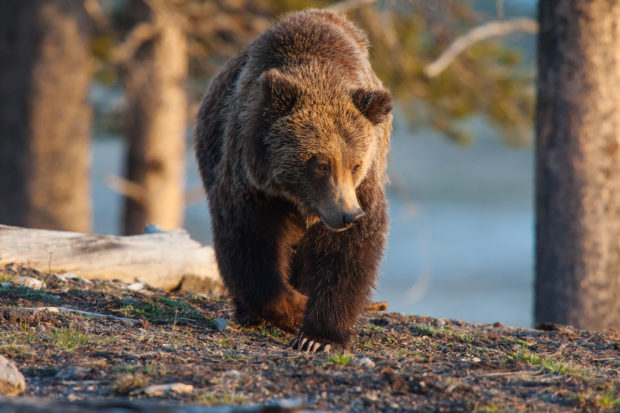The U.S. Fish and Wildlife Service and the states of Idaho, Montana, and Wyoming are aligned on the idea of removing federal Endangered Species Act protections for Greater Yellowstone Ecosystem grizzly bears, and we could be looking at a federal delisting as early as this autumn. This, despite the fact that most of the American public polled wants these bears to remain protected, and fewer Americans still have any stomach for the thought of the states unleashing trophy hunters to kill these animals for the first time in decades in the lower 48 states.
Even while federally protected, grizzly bears are fighting for their lives. According to data released by the Interagency Grizzly Bear Study Team (IGBST), the bears’ 10-year mortality trend has increased at a rate that should prompt federal wildlife managers to redouble conservation efforts, not turn the management of bears over to states hell-bent on adding yet another form of human-caused mortality. A new IGBST document reveals a record number of Greater Yellowstone Ecosystem (GYE) grizzly bear deaths in 2015. With the help of longtime grizzly bear advocate Louisa Willcox, we’ve discovered that 85 GYE bears died last year, including Scarface, a 25-year-old iconic Yellowstone grizzly bear, who was shot and killed outside the park’s boundary. This year, a record 35 bears have already been killed, and we haven’t even made it to fall, when most bear deaths occur. There’s no way this is acceptable or sustainable, and it makes it pretty darn clear that delisting is flat-out dangerous for the health of this population.
 Grizzly bears are a primary lure for millions of people who come to Yellowstone. Above, a grizzly foraging in Yellowstone.
Grizzly bears are a primary lure for millions of people who come to Yellowstone. Above, a grizzly foraging in Yellowstone.
Photo by Thomas D. Mangelsen/www.mangelsen.com
The removal of federal protections comes at the same time that grizzly bears’ historic major food sources — such as whitebark pine seeds and cutthroat trout — are in decline because of human causes, including climate change. As a result, grizzly bears must turn to foods either outside the safe boundaries of the Park, or rely on elk, deer, and other large animals inside the park – which often puts the bears, especially young cubs, at risk of predation from other native carnivores.
To get to the delisting finish line, Montana and Wyoming have fast-tracked their public processes, illegally tripping over public notice requirements, withholding key documents from public view, and otherwise failing to fully keep the public in the loop. To hold them accountable, The HSUS, along with the Center for Biological Diversity and a retired U.S. Geological Survey employee, filed a lawsuit challenging the Montana Fish and Wildlife Commission’s illegal adoption of grizzly bear hunting regulations that open the door for trophy hunting once the bears are stripped of Endangered Species Act protections. The Commission voted to approve a regulation that was not even made available to the public. This follows on the heels of our ongoing litigation in Wyoming, where the commission adopted grizzly hunting regulations without giving the public sufficient time to comment on reams of public documents. It’s become clear that the states – like FWS – are committed to delisting GYE bears as quickly as possible, even if that means running roughshod over public input, scientific dissent, and state law.
The USFWS plans to allow the public to comment on its delisting proposed rule, but not on the GYE grizzly bear Conservation Strategy Plan, which was substantially altered by a panel of biologists, none of whom were GYE grizzly bear experts (one, for example, was an expert on the black bears of Kentucky). The new Conservation Strategy Plan fails to provide for a sufficient no-hunting buffer around the Yellowstone National Park, a fact that caused Superintendent Dan Wenk to protest, to no avail, at a recent meeting.
There’s just no compelling reason for the feds to put these bears at the mercy of the states. This is a small population of a few hundred bears that is geographically isolated, and at risk from a growing array of threats. The new mortality data alone should cause federal officials to slam on the brakes for its delisting effort. What’s more, the bears are a primary lure for millions of people who come to Yellowstone. Yes, they love to see the waterfalls,hot springs, and other features of the landscape, but they are most interested in seeing the bears and the wolves. How’s allowing hunters to kill them in the fall going to play with the public?
The states have dealt with a no-hunting standard for decades, and there’s no reason to discard that sensible policy, especially as public attitudes have solidified around the position that killing these animals for their heads is unacceptable. When there are conflicts, there are a host of practical, non-lethal solutions, such as removing stillborn calves and lambs from the landscape, that can deter grizzly bear conflict by over 90 percent.
The HSUS remains strongly opposed to the proposed delisting. The best available science indicates that these animals require far more protections right now, not less. The public process involved has been deplorable and the agencies involved do not seem to be aware of either the science or what the majority of the public wants.
The post Grizzly bears under the gun in Yellowstone region appeared first on A Humane Nation.
Enviroshop is maintained by dedicated NetSys Interactive Inc. owners & employees who generously contribute their time to maintenance & editing, web design, custom programming, & website hosting for Enviroshop.
